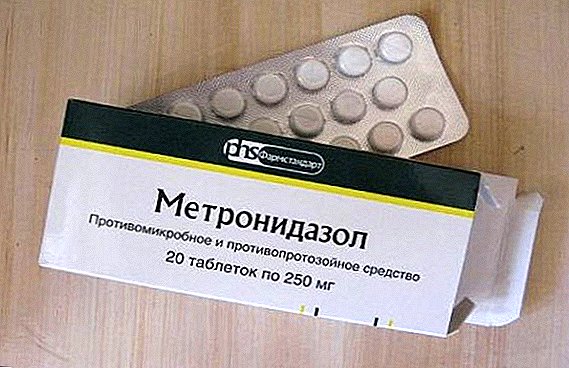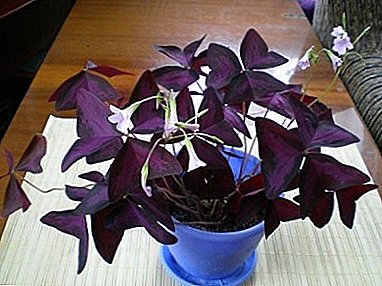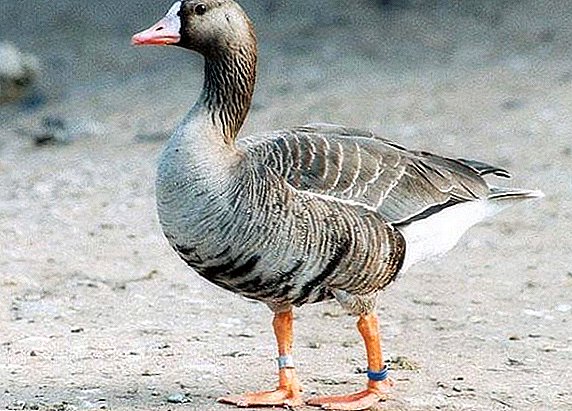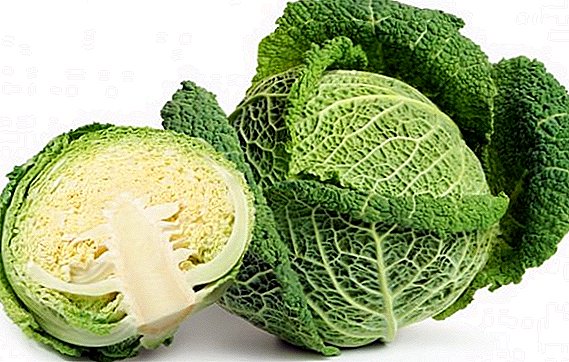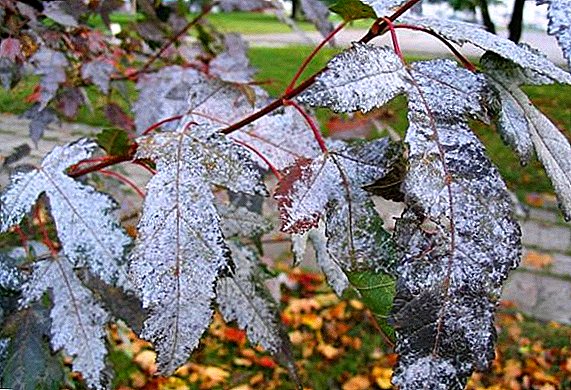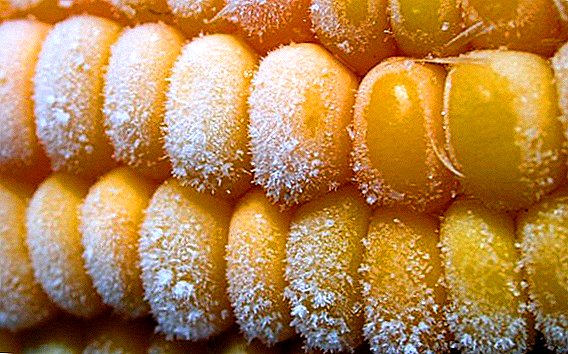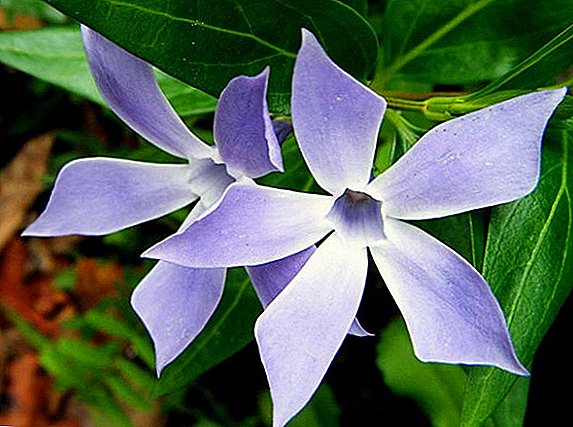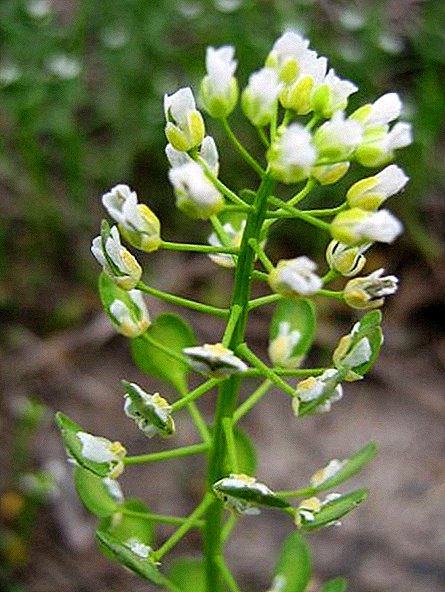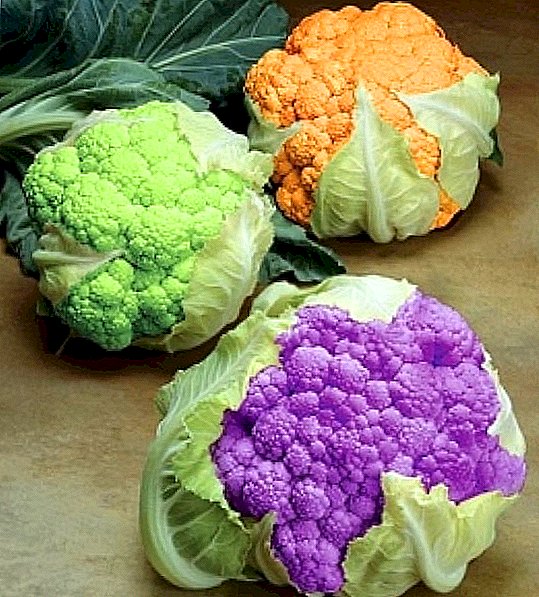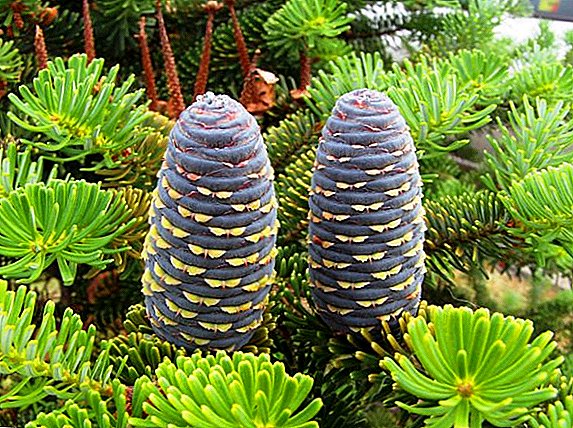 The dacha has long ceased to be a place for growing potatoes, and modern gardeners with great enthusiasm decorate their plots with ornamental plants. One of these is Korean fir, which this article will tell about planting and care.
The dacha has long ceased to be a place for growing potatoes, and modern gardeners with great enthusiasm decorate their plots with ornamental plants. One of these is Korean fir, which this article will tell about planting and care.
Korean fir: plant description
 Speaking of Korean fir, it is important to specify its description, since this tree has a number of differences from its more popular relatives. Under natural conditions, the Korean fir is a giant tree that can grow up to 14 meters in height. The trunk of such a tree can have a diameter of about 1 meter.
Speaking of Korean fir, it is important to specify its description, since this tree has a number of differences from its more popular relatives. Under natural conditions, the Korean fir is a giant tree that can grow up to 14 meters in height. The trunk of such a tree can have a diameter of about 1 meter.
But when growing ornamental varieties of this tree it is rarely possible to achieve similar results, although the common features are still:
- Korean fir tree has an attractive cone-shaped crown;
- the needles on the tree have an unusual emerald color, although the lower part of each needle is silver, with a wax streak;
- Korean fir has a peculiar shape of a cone, which is purple in color and large in size - up to 10 cm in height and 4 cm in width; cones usually rise up on the branches, which gives the tree a special elegance;
- bark color is reddish, although young shoots usually have a yellow color;
- the branches on the trunk of a tree are rather thick, making it very attractive and even a bit like artificial fir;
- Korean fir has excellent winter hardiness, which is comparable to the resistance to frost of the Siberian cedar; thanks to this, it can be grown not only in the latitudes of Ukraine, but also in the northern part of Belarus and in the coldest regions of Russia;
- in the summer, this tree no less steadfastly tolerates droughts, especially when it comes to adult representatives of the species.
Did you know? In addition to decorative properties, Korean fir also perfectly cleans the air at the site and collects harmful microelements with its needles. In addition, it has a pleasant pine aroma.
Varieties of Korean fir for growing
Planting Korean fir at random can lead to the fact that the variety you have chosen does not take root in your area or may disappoint with its decorative qualities. In addition, Korean fir has two varieties at once - tall varieties with pyramidal or conical crowns, and short-growing ones, whose crown is more similar to a flattened ball.
It is worth noting that among the Korean fir there are species that differ in the shape of the cones, and the color of the needles, and preferences in relation to growth conditions, Therefore, we consider the most popular varieties in more detail:
- Diamond. Dwarf Korean fir, which differs pincushion crown and grows in diameter not more than 70 cm, and in height - only 0.5 meters. Differs thick dark green needles with a bluish bottom. Needles themselves are soft, have a length of up to 2 cm. Cones are not typical for this variety.
It is best acclimatized in those areas where there are no winds and drafts, but there is a lot of light. It is better to choose the soil slightly acid and loose. If it is characterized by weak fertility, then this problem can be corrected independently. Korean diamond fir is best planted in containers or on rocky gardens.
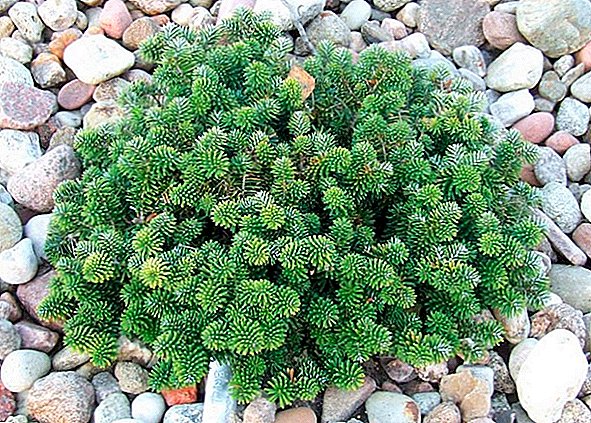
- Silberlock. This is a tall tree that can reach a height of more than 5 meters. Differs cone-shaped crown, while the main trunk in it is often missing or difficult to distinguish. The main drawback is slow growth (for the year it grows no more than 12 cm). Among the advantages are an interesting bent up "curly" needles of dark green color and 7-centimeter green-purple cones.
The variety tolerates frosts, but its branches can break under the weight of snow. When planting this variety, choose bright places with sour and loose soils. The Silberlock variety is ideal for single planting, creating Japanese gardens or decorating rockeries.
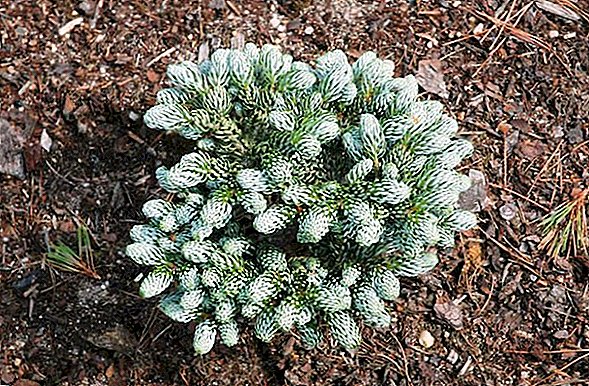
- Molly. Large tree, the maximum height of which can reach 7 meters. The krone has a conical shape, its diameter is about 3 meters. Differs bright green color very thick needles, which in the lower part may have a bluish-gray color. Cones are very attractive, because they differ in purple-blue color. Their length is small - only 5 cm, but they very densely cover the branches of a tree.
Molly fir grade loves to grow in well-lit areas that are not blown by the winds. Does not like strong watering, although it is necessary to water the tree often. Best used for single landings.
- Compact. Another dwarf representative of Korean fir, which is characterized by a compact and symmetrical crown only 80 cm in height. Such a tree is more like a slow-growing shrub (annual growth is only 5-7 cm). Another feature of the variety is the dense and long needles (4 cm) of the blue shade. But cones can be found extremely rarely, as in all representatives of dwarf fir.
For good growth, this variety is recommended to be planted in well-lit areas where there is sandy or loamy soil with a high humus content. Fir "Compact" is most often used for planting in containers and rock gardens. It survives well near ponds and walkways.

- Blue Emperor. The tree of this variety has a small height (only about 1.5 meters) and a dense compact pillow without a pronounced center. During the year it grows about 6 cm. It differs in short, thick and soft needles, the upper part of which has a violet-silver color, and the lower part is white. Cones are also purple or dark blue, small in size.
It is practically the only variety of Korean fir that can grow in slightly shaded areas, and also likes moist nutrient soils (but do not forget about drainage). Best of all, the variety is able to adorn alpine slides and oriental gardens.
Important! At the summer cottage fir can be planted not only for decoration, but also to protect other plants from the wind. It is noteworthy that this conifer perfectly coexists not only with its relatives, but also with fruit and berry bushes and trees.
Features of Korean fir planting
Since the birthplace of fir is a moderate and subtropical belt, it follows from this that the tree is not able to take root in all areas. Therefore, the place for its landing should be chosen with special care, and sometimes make significant changes to your site. 
Choosing a landing site
Features of the choice of a place for Korean fir are largely dependent on the selected species of this tree. But the basic requirements will be as follows:
- good lighting, since shade and partial shade are destructive for most varieties;
- absence near other large trees, especially if you want to plant varieties of tall fir;
- lack of strong drafts, to which young seedlings are especially intolerable.
Important! Consider that the fir grows slowly, however in adulthood it will be quite large. Therefore, when planting try as far as possible to retreat from buildings and other trees. Another feature of this plant is the superficial bedding of the roots, which also will not allow planting large plants near.
Soil requirements
Korean fir when grown does not require a lot of nutrients, so the soil for its planting, you can choose almost any. Even loamy soils and heavy soils that the plant is able to “refine” over time, making their composition more structured, will be suitable for this purpose.
It is best to plant Korean fir on sandy soils or other types of light soils with a large amount of organic matter. Acid soils for this purpose also fit. 
Consider only that the fir does not like wetlands, as well as areas that are flooded with water in the spring. If your site is just that, take care of a good drainage system in advance.
How to plant a Korean fir
Having decided on the place of planting, let's look at how to plant Korean fir seedlings so that they not only take root, but also grow into an attractive shrub.
First, the ideal time for planting is early spring, while young buds and shoots have not yet appeared on the seedlings.
Secondly, the sapling should be at least 4 years old for planting, although even 10-year-old trees are excellent for this purpose. Younger seedlings are not recommended to be used, since in the summer they will suffer due to strong light, and in winter they can die from frost.
We prepare deep pit for a sapling. In this matter, it is important to take into account the characteristics of the variety - the larger the crown and root system, the larger the pit should be. On average, its depth can vary from 50 to 80 cm. When preparing a hole in it, it is important to fill the mixture of soil dug out of it with humus and peat (take 1 part of the soil from the site and 0.5 humus and peat).
Having poured this mixture into a hole with a knoll, give it time to sit down, then take a planting - straighten the roots of Korean fir over an earthen hill and cover it with remnants of soil. After planting, the fir is plentifully watered with several buckets of water, and the near-stem circle is mulched.  It is very important that when planting in the soil the root neck does not penetrate. If it turns out to be underground, the tree will not grow and after a while it may even die.
It is very important that when planting in the soil the root neck does not penetrate. If it turns out to be underground, the tree will not grow and after a while it may even die.
Important! When planting fir, you can pursue two goals - the cultivation of single lush trees or the creation of a hedge. In the first variant, it is necessary to leave the distance between the trees at least 5 meters, and in the second - only 2 meters.
How to care for Korean fir
Korean fir, in addition to proper planting, requires and care, which is important to build on the needs of the tree, as well as on the basis of the soil on your site and the time of year. Separate attention will require trees that were planted in decorative containers. Watering and feeding they need more often.
Watering the plants and caring for the soil
Moisture is more necessary for young seedlings that do not yet have a strong root system. In particular, immediately after planting it is worthwhile to add moisture to the soil every 10-15 days. Similarly, it is worth doing with those Korean fir trees that are grown in containers.
As for the adult large trees, it is worth not more than 2-3 times to add moisture under them during one growing season, as the fir refers to drought-resistant plants. However, if the summer turns out to be very dry, it will not be superfluous to organize two-times watering during the month. 
After each watering do not forget to weed the soil around the fir and loosen it. In spring and autumn, the near-stem circle can be covered with mulch, so that moisture is better preserved in the soil, and nutrients are fed from the mulch to the roots. As mulch is recommended to use sawdust or disinfected needles. Due to this, the soil will become more permeable to moisture and air, and about the weeds do not even have to worry.
Important! Young seedlings will also require special attention in the fall, since they must be covered before the winter so that the frost does not damage the trees.
Top dressing of the Korean fir
Fertilizer application for fir should not be frequent, as this tree is not demanding for them. The first dressing should be carried out no earlier than 3-4 years after planting a tree on the site. For this purpose, it is recommended to use special liquid preparations intended for coniferous trees. On 1 square. m near-barrel area will require no more than 100-120 g of the drug.
Pruning Korean Fir
As such, pruning for Korean fir is not needed. However, in order to achieve branchy and most dense needles, it is very important to prune the central shoots. In addition, annually it is necessary to remove dried pine needles, cones and branches, thereby improving the decorativeness of the tree.
Important! Korean fir, like the rest of its relatives, is intolerant of transplants. Therefore, if you are already going to plant a sapling, then try to choose the most ideal place for it.
Major pests and plant diseases
Having decided how to plant Korean fir and how to take care of it, it is important to understand that this conifer is quite vulnerable to various diseases and pests, as it has juicy needles - the best food and shelter for different parasites. We list the most common problems of these trees and methods for their elimination:
- Aphid hermes, about the appearance of which will tell white scurf on the needles. Damaged needles must be removed, and in case of severe injuries we spray with systemic insecticides. For prevention, we plant near spruce and larch.

- Shatter-panwhich is marked by browning and drying of needles, branches and the presence of honey drops of moisture. It is necessary to fight with it in the spring, putting on a sackcloth soaked with glue from caterpillars on a tree trunk.
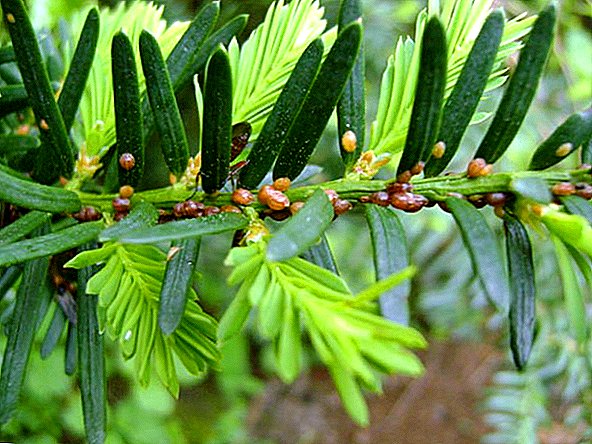
- Spider mite leaves behind on the needles not only the web, but also the yellow heel, which later turn brown and cause the needles to fall. The most common tick appears in hot and dry weather, so for prevention it is important to regularly spray branches of fir with cold water (but it should be done either early in the morning or late in the evening). To combat the pest using infusions of garlic or dandelions.
- Fir moth It is also capable of destroying fir needles, as it feeds on its juice. Only deep digging of the near-barrel circle each spring will help to destroy it. Young butterflies are fought by spraying with biological preparations.
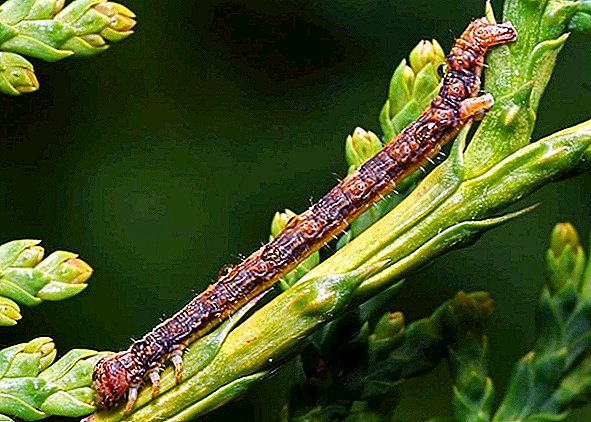
- Fungi they can damage fir in sudden temperature changes or when damage is caused to the tree (for this reason it is not recommended to cut the fir). The fungus, in turn, can cause diseases such as brown schutte or fusarium. To correct the tree from this, a proper planting will help without a strong deepening of the seedling, as well as processing with biological products for conifers.
Did you know? Attempting to plant and grow Korean fir in the midst of a noisy metropolis may not succeed, because excessive air pollution will destroy the plant.Korean fir in the cultivation and care is quite simple, but for this it is necessary to first choose the right variety for planting in your region and the place in which the fir will feel comfortable. If the tree takes root - then it will become the most trouble-free decoration of your site.








